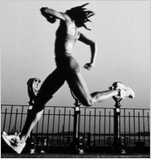 David
Stewart/Getty Images
David
Stewart/Getty ImagesWe’re all used to hearing that everything we once thought was good for us is not. But even within that framework, the latest science about antioxidants, free radicals and exercise is telling. As many of us have heard, free radicals are molecules created by the breakdown of oxygen during metabolism. Each of us constantly creates free radicals simply by living and breathing. But these molecules are highly reactive and capricious, sometimes attacking other cells and damaging tissue. Wilding free radicals have been linked with a number of diseases and with aging. Exercise, because it requires increased oxygen consumption, also increases the production of free radicals. So, many experts began urging the fitness-minded to pop large doses of antioxidant vitamin supplements, like vitamins C and E, to counteract the presumed damaging effects of the free radicals. Food alone would not supply sufficient levels of the necessary antioxidants, it was thought. The exercising body needed help from vitamins.
But then a few years ago, researchers from the University of Valencia in Spain and the University of Wisconsin in Madison set out to study what would happen if you tried to prevent exercising muscles from creating free radicals. They had laboratory rats run on small treadmills until they were exhausted. Some of the rats had been injected with a powerful, pharmaceutical-grade antioxidant that works in the body to halt the production of most free radicals. After the rats ran, the researchers measured the levels of a number of substances in their leg muscles. Not surprisingly, the injected rats showed almost no free-radical activity. They were virtually immune to what scientists had considered a kind of bodily damage.
The leg muscles of the other exercised rats, though, teemed with free radicals. But at the same time, they buzzed with other, unexpected biochemical reactions. In their legs, genes were being expressed that activated growth factors that, in turn, increased levels of ‘‘important enzymes associated with cell defense’’ and ‘‘adaptation to exercise,’’ the researchers wrote. There was hardly any similar activity in the rats with low free-radical levels. Somehow, the researchers speculated, the free radicals had jump-started a process that over time would allow the rats’ muscles to adapt to exercise. Suppressing the production of free radicals had, they concluded, prevented the ‘‘activation of important signaling pathways’’ and altered the muscles’ ability to adapt to exercise. As a result, they wrote, ‘‘the practice of taking antioxidants’’ to ward off the presumed free-radical damage caused by exercise ‘‘may have to be re-evaluated.’’
They published their findings in 2005, and since then a number of other studies have replicated and expanded on their results, to thought-provoking effect. One of the most reverberant experiments, published last year, enrolled a group of young men in a monthlong exercise program. Some swallowed moderately high doses of the antioxidant vitamins C and E. Others did not. At the end of the month, the men not taking the vitamins showed higher-than-average activity in their bodies’ innate antioxidant defense system. The men downing the vitamins did not, which makes sense; the antioxidant vitamins were mopping up the free radicals for them. But at the same time, the men not taking vitamins significantly increased their insulin sensitivity, a key measure of the health benefits of exercise, while those taking the antioxidants did not. Apparently, when the body’s natural antioxidant defense system went into high gear, so did its ability to handle insulin. Removing the necessity for the body to deal, on its own, with the free radicals also prevented other adaptations that make exercise healthy.
What these findings mean for those of us who work out regularly is still being determined by scientists. But one message is clear. ‘‘The evidence suggests that antioxidants are not needed’’ by most athletes, even those training strenuously, said Li Li Ji, a professor of exercise physiology and nutritional science at the University of Wisconsin and one of the authors of the rat study. ‘‘The body adapts,’’ he said, a process that can, it seems, be altered by antioxidant supplements.
Another lesson: ‘‘Eat well,’’ he said. Although this is not yet proved, it seems likely, he continued, that antioxidants from foods, like blueberries, green tea and carrots, may work in tandem with the body’s natural antioxidant defenses better than those from supplements.
But the overriding lesson of the newest science about exercise and antioxidants may be as simple as: let the body be. ‘‘It is quite a smart machine,’’ Dr. Ji said. ‘‘It knows how to respond’’ to stresses like a hard run, without the need for antioxidant pills.
